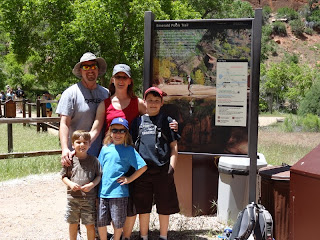In the Bible, Zion was the hill in Jerusalem on which the Temple was built. Zion means promised land. It makes perfect sense why Zion National Park was given its name. It is a remarkably beautiful place with amazing views every which way you look. You can defintely sees God's hand at work here. It is a great place to take the kids to really appreciate God's majesty. Plus, it is a great place for the kids to learn more about geology and history. You can see why we rounded out our May vacation in this incredible place.
 |
| The boys talking to the Ranger, getting their books signed. |
The park doesn't allow private vehicles to tour around, and instead has a shuttle that takes you around the park, dropping you off at the various trails and sites of interest. This is actually a great resource, because as you're traveling in, the shuttle plays a recording describing the areas and some of the history and background. We found this very helpful and informative.
We decided to only hike a couple of easy trails, so as to not overwhelm the kids, especially Bode. Our first stop was the Weeping Rock Trail. This was a short, but steep, trail which the kids handled well. The trail ended at a rock alcove with dripping springs, hence why the rock looks like it's weeping. It also had hanging gardens at the alcove, where the water is seeping, providing a place for plants and flowers to grow out of the rocks.
 |
| Weeping Rocks |
 |
| Lunch break, enjoying the views |
The beautiful rocky cliffs of Zion were created through deposition of thousands of feet of mud, lime, sand, and ash. The pressure and heat of these accumulating sediments turned its lower layers to stone. These layers were then uplifted by underground forces (the uplifting of the Colorado Plateau). Water worked into the cracks to loosen the grains and widen the fractures, causing the canyon to form. Erosion continues to occur in this area, with the rushing Virgin River moving and deposting sediments, as well as earthquakes and rockfalls.
 |
| The Virgin River |
 |
| A friendly bird |
 |
| Baby squirrels! So cute! |
 |
| Mama squirrel carrying her baby |
Our next hike was the Lower Emerald Pool Trail, which started off of Zion Lodge. This trail was only 1.2 miles roundtrip, but Bode didn't even make it to the pools before I had to carry him in (and Darin carried him back). But Bode still enjoyed the scenic views (from our backs).
 |
| From the cottonwood trees that line the river |
 |
| One more Junior Ranger badge |
As you can tell by the myriad of pictures, we had a great time here. Zion is a beautiful place and definitely somewhere we want to visit again and again. It is rich in history, science, beauty, and tranquility.


















































